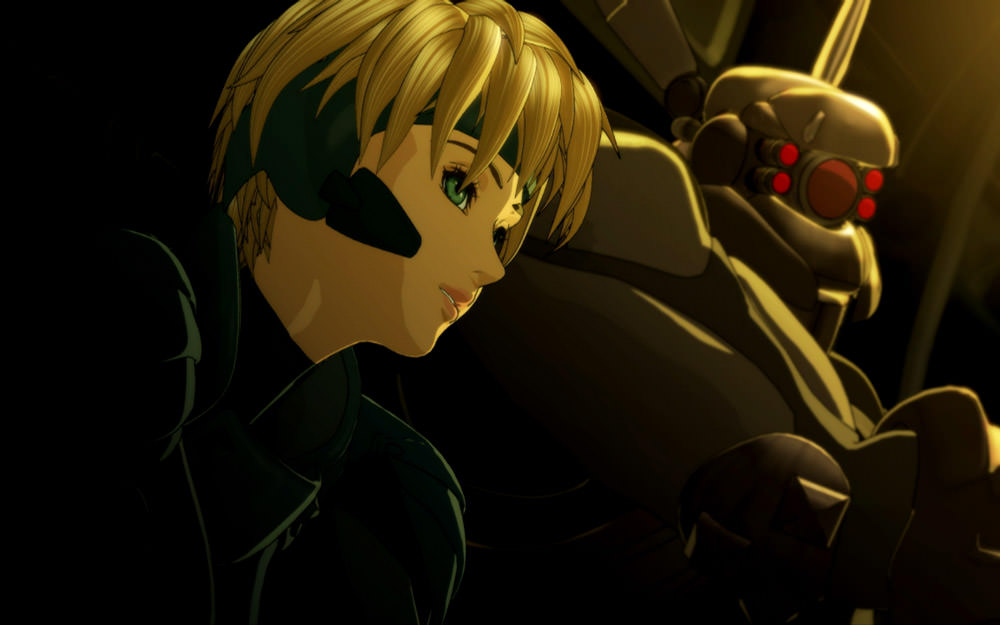
The works of Masamune Shirow hold a pretty special place for me, as they represent some of my very first forays into the worlds of anime and manga. Back in high school, I watched both of the (rather lackluster) Appleseed and Black Magic M-66 movies, and later on, Ghost in the Shell served as my initial exposure to “mature” anime (as it did for a number of people). Looking back, what initially drew me to Shirow’s work was the insane amount of technical detail. Shirow is renowned for having something of a technology fetish, and that’s quite evident in his incredibly complex and realistic designs for futuristic technology — namely mechas.
Appleseed, Shirow’s debut work, is chock-full of this sort of fetish. The mecha and tech designs are taken to extreme limits, from the organic-looking landmates with their insect-like antennae and bulbous protrusions to the apparently limitless variation of firearms. Appleseed doesn’t delve into the issues of humanity and technology in quite the same manner as Shirow’s other popular work, Ghost in the Shell. Rather, it feels more like a fanboy work than a serious philosophical treatise. However, that doesn’t mean that it’s merely popcorn entertainment either.
The original Appleseed OVA that came out in 1988 was rather disappointing. Although the storyline was intriguing, and not too dissimilar from the plot of this movie, it wasn’t fleshed out very well and ended up feeling like several distinct plotlines simply thrown together. And while the mecha designs were quite unique, the animation was nothing to write home about (and would probably seem even more dated now).
This Appleseed movie, however, is something else entirely. Directed by Shinji Aramaki (who has worked with other techno-minded titles such as Bubblegum Crisis) and produced by Fumihiko Sori (who directed the fantastic Ping Pong, one of the best Japanese films in recent years), Appleseed truly delivers on the potential of Shirow’s manga series.
Set at some point in the distant future, Appleseed finds the world ravaged by yet another war, and the survivors continue to fight battles amongst the ruins of Earth’s cities. Deunan Knute is one of these survivors, a young woman who has spent her entire life fighting. When the film opens, her squad has just been wiped out by a group of robotic assassins. Despite some fancy legwork, she’s about to join her teammates when she’s rescued by another group of soldiers utilizing technology unlike anything she’s seen.
When Deunan awakens, she finds herself in completely different surroundings. She’s been taken to the last remaining human city, a veritable utopia named, appropriately enough, Olympus (the first example of the series’ fascination with ancient Greek mythology). Her rescuer, a young woman named Hitomi, reveals Olympus’ secrets form peace — the city is actually controlled by a supercomputer named “Gaia” and half the population are actually clones called “bioroids.” Since bioroids’ emotions are carefully controlled, they aren’t prone to the same passions as real humans, and so act as a buffer and mediator.
Naturally, however, some aren’t too happy with this state of affairs. Fearing that bioroids are in a position to control humans, a group begins striking back at bioroids, destroying their repair facilities and planning to unleash a virus that will kill all bioroids.
Deunan, whose combat skills are so renowned that they’re even known in Olympus, is quickly recruited into Olympus’ police department. There, she is reunited with her old comrade and lover Briareos, now a faceless cyborg due his wartime injuries. What seems like a simple terrorist plot soon evolves into something much more insidious, and soon Deunan is facing betrayal at every turn, even from her closest friends.
Much of Appleseed’s appeal will undoubtedly be due to its unique visuals. Although not the first all-CGI anime, Appleseed makes use of what its creators term “3D Live Anime.” Utilizing a combination of CG, motion capture for the characters’ movements, and facial imaging for their “acting,” the film is truly a site to behold.
The most impressive visuals are in the technical realm, namely the various mecha, vehicles, gadgets, and weaponry that pop up throughout the film. The CG allows for an incredible level of technical detail, from each little moving part to the way the sunlight glints off of the metal surfaces, from the way spent shell casings fall to the way the mecha shift and balance themselves as they move about.
When it comes to the actual characters, this particular approach becomes something more of a liability. Although the filmmakers did employ various shading techniques to make the CG models look more like traditional cell animation, the characters still have a very plastic, action figure-y look about them. And though the motion capture lends a new level of realism to the action sequences, there are other times when the characters’ movements are too perfect and realistic and become a little unnerving.
Appleseed never felt as “deep” as Ghost in the Shell did, though much of Ghost in the Shell’s depth was undoubtedly due to Mamoru Oshii’s involvement. But even so, Appleseed wrestles with some weighty issues, especially in this day and age of cloning and euthanasia. Although certain plot points get wrapped up a little too neatly, there are moments where the dialog feels like it’s been ripped out of recent headlines, especially when it begins dealing with mankind’s power over life, with whether or not we have the ability to decide what, exactly, constitutes life and said life’s usefulness and purpose.
It’s entirely possible to enjoy Appleseed as sheer visual spectacle — it certainly packs a lot of really cool-looking mecha, even cooler-looking guns, and plenty of explosions into its 100 minutes — without looking for any sort of deeper meaning. But the reclusive Shirow has always had a point somewhere beneath his flashy, distinctive, and intricate visuals. Which is something this latest incarnation of his work definitely brings out for those with open eyes.
